Research Proposal: Leadership Style and Employee Motivation at Tesco
VerifiedAdded on 2020/01/06
|9
|2568
|226
Report
AI Summary
This research proposal investigates the correlation between leadership styles and employee motivation, focusing on Tesco plc in the UK retail sector. The study aims to assess how leadership styles, including autocratic and democratic approaches, influence employee motivation. The proposal outlines the research questions, background, and a review of literature highlighting the impact of different leadership styles on workforce engagement and productivity. The methodology includes a descriptive research design, an inductive approach, and both primary and secondary data collection methods, involving interviews with Tesco leaders and analysis of existing literature. The research also addresses potential limitations, ethical considerations, and a detailed timeline for completion. The findings are expected to provide insights into effective leadership practices for enhancing employee motivation within Tesco and the broader retail industry.
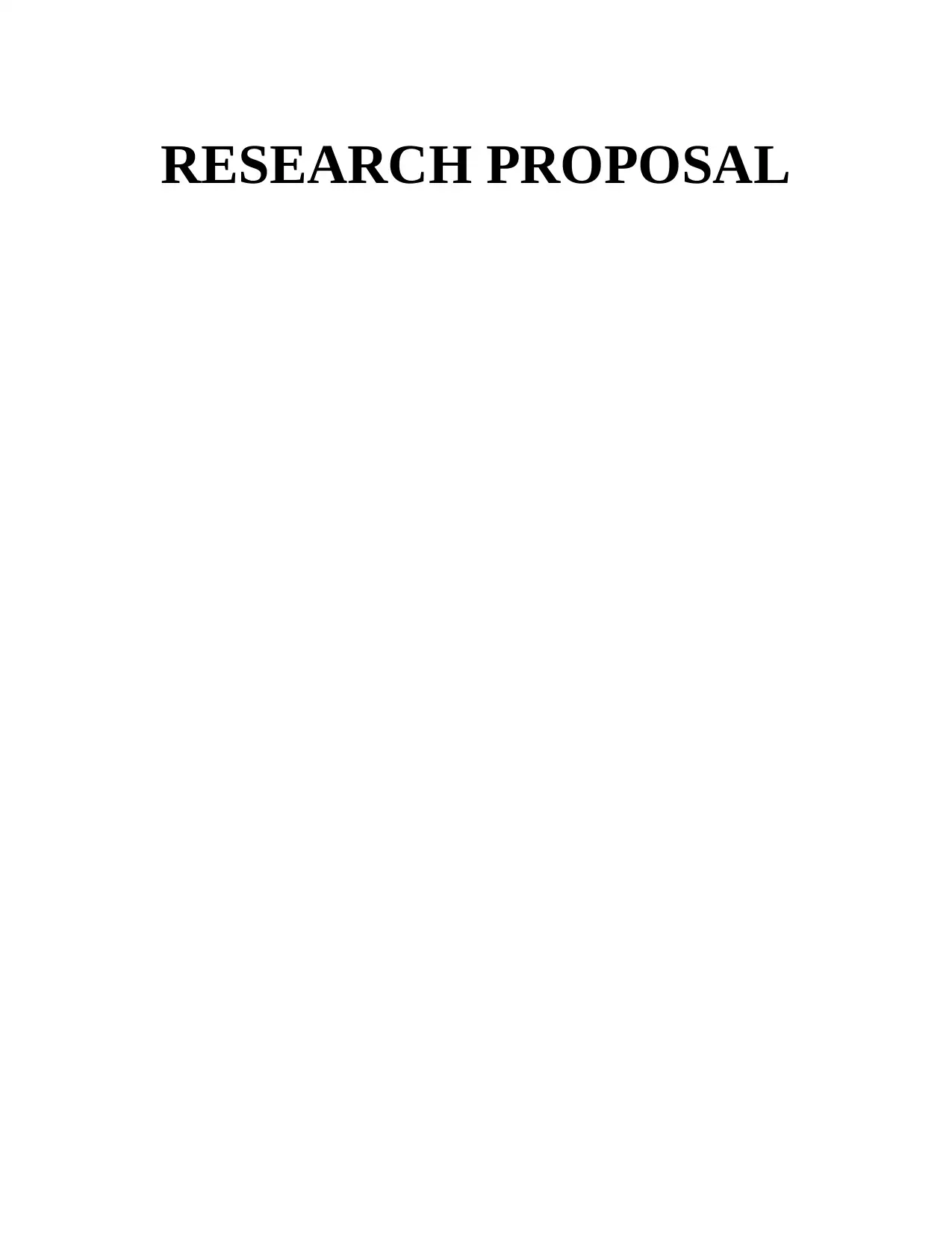
RESEARCH PROPOSAL
Paraphrase This Document
Need a fresh take? Get an instant paraphrase of this document with our AI Paraphraser
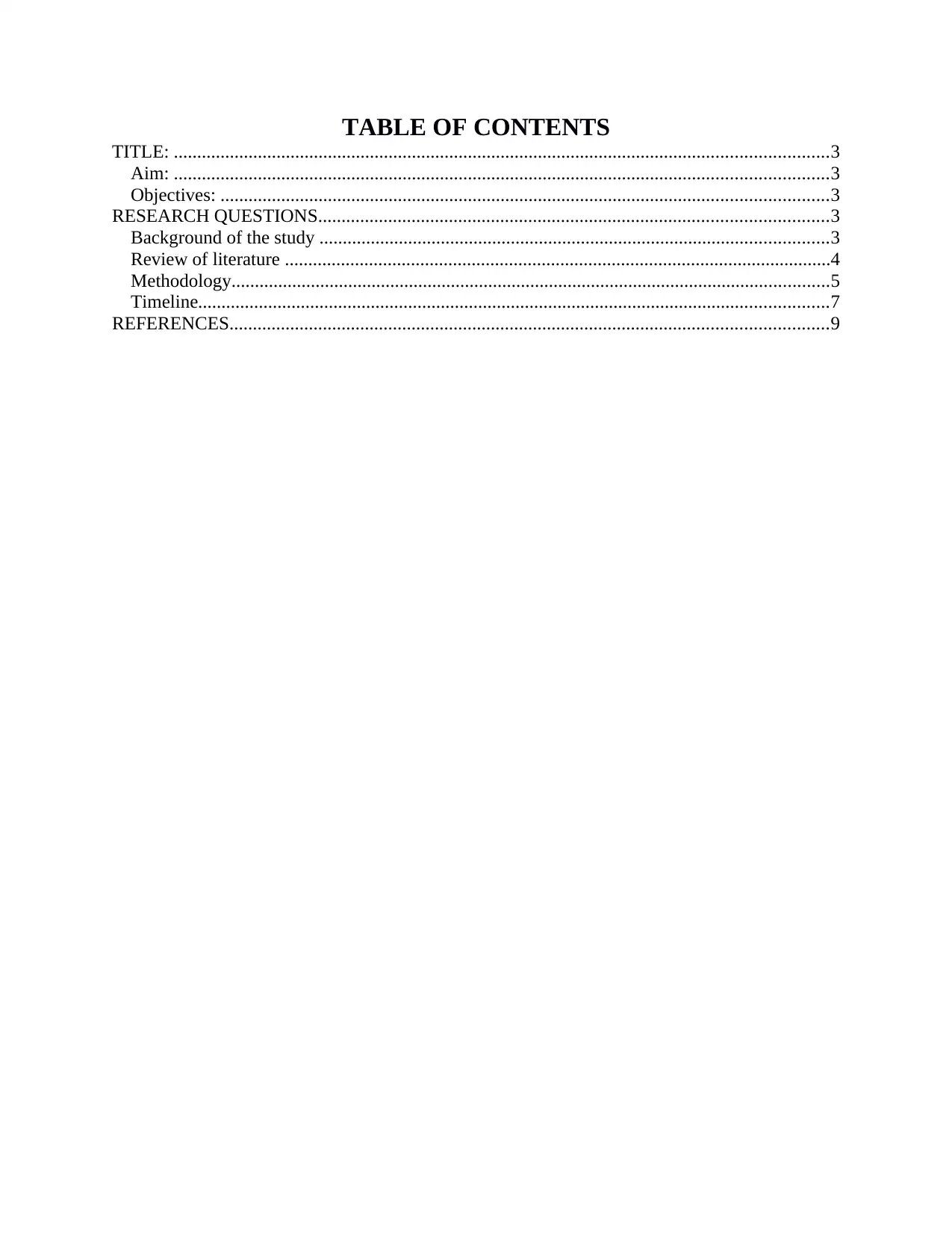
TABLE OF CONTENTS
TITLE: ............................................................................................................................................3
Aim: ............................................................................................................................................3
Objectives: ..................................................................................................................................3
RESEARCH QUESTIONS.............................................................................................................3
Background of the study .............................................................................................................3
Review of literature .....................................................................................................................4
Methodology................................................................................................................................5
Timeline.......................................................................................................................................7
REFERENCES................................................................................................................................9
TITLE: ............................................................................................................................................3
Aim: ............................................................................................................................................3
Objectives: ..................................................................................................................................3
RESEARCH QUESTIONS.............................................................................................................3
Background of the study .............................................................................................................3
Review of literature .....................................................................................................................4
Methodology................................................................................................................................5
Timeline.......................................................................................................................................7
REFERENCES................................................................................................................................9
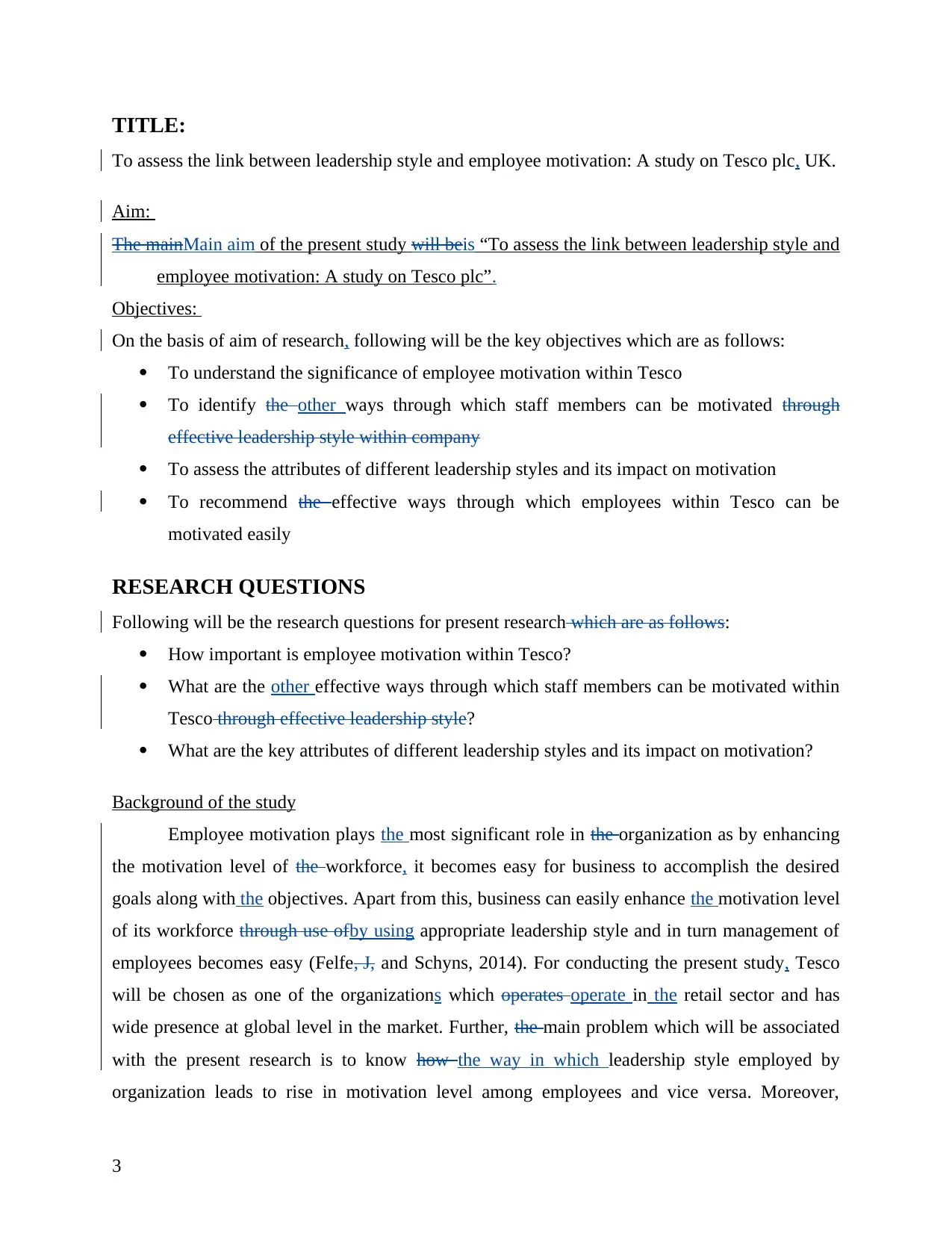
TITLE:
To assess the link between leadership style and employee motivation: A study on Tesco plc, UK.
Aim:
The mainMain aim of the present study will beis “To assess the link between leadership style and
employee motivation: A study on Tesco plc”.
Objectives:
On the basis of aim of research, following will be the key objectives which are as follows:
To understand the significance of employee motivation within Tesco
To identify the other ways through which staff members can be motivated through
effective leadership style within company
To assess the attributes of different leadership styles and its impact on motivation
To recommend the effective ways through which employees within Tesco can be
motivated easily
RESEARCH QUESTIONS
Following will be the research questions for present research which are as follows:
How important is employee motivation within Tesco?
What are the other effective ways through which staff members can be motivated within
Tesco through effective leadership style?
What are the key attributes of different leadership styles and its impact on motivation?
Background of the study
Employee motivation plays the most significant role in the organization as by enhancing
the motivation level of the workforce, it becomes easy for business to accomplish the desired
goals along with the objectives. Apart from this, business can easily enhance the motivation level
of its workforce through use ofby using appropriate leadership style and in turn management of
employees becomes easy (Felfe, J, and Schyns, 2014). For conducting the present study, Tesco
will be chosen as one of the organizations which operates operate in the retail sector and has
wide presence at global level in the market. Further, the main problem which will be associated
with the present research is to know how the way in which leadership style employed by
organization leads to rise in motivation level among employees and vice versa. Moreover,
3
To assess the link between leadership style and employee motivation: A study on Tesco plc, UK.
Aim:
The mainMain aim of the present study will beis “To assess the link between leadership style and
employee motivation: A study on Tesco plc”.
Objectives:
On the basis of aim of research, following will be the key objectives which are as follows:
To understand the significance of employee motivation within Tesco
To identify the other ways through which staff members can be motivated through
effective leadership style within company
To assess the attributes of different leadership styles and its impact on motivation
To recommend the effective ways through which employees within Tesco can be
motivated easily
RESEARCH QUESTIONS
Following will be the research questions for present research which are as follows:
How important is employee motivation within Tesco?
What are the other effective ways through which staff members can be motivated within
Tesco through effective leadership style?
What are the key attributes of different leadership styles and its impact on motivation?
Background of the study
Employee motivation plays the most significant role in the organization as by enhancing
the motivation level of the workforce, it becomes easy for business to accomplish the desired
goals along with the objectives. Apart from this, business can easily enhance the motivation level
of its workforce through use ofby using appropriate leadership style and in turn management of
employees becomes easy (Felfe, J, and Schyns, 2014). For conducting the present study, Tesco
will be chosen as one of the organizations which operates operate in the retail sector and has
wide presence at global level in the market. Further, the main problem which will be associated
with the present research is to know how the way in which leadership style employed by
organization leads to rise in motivation level among employees and vice versa. Moreover,
3
⊘ This is a preview!⊘
Do you want full access?
Subscribe today to unlock all pages.

Trusted by 1+ million students worldwide
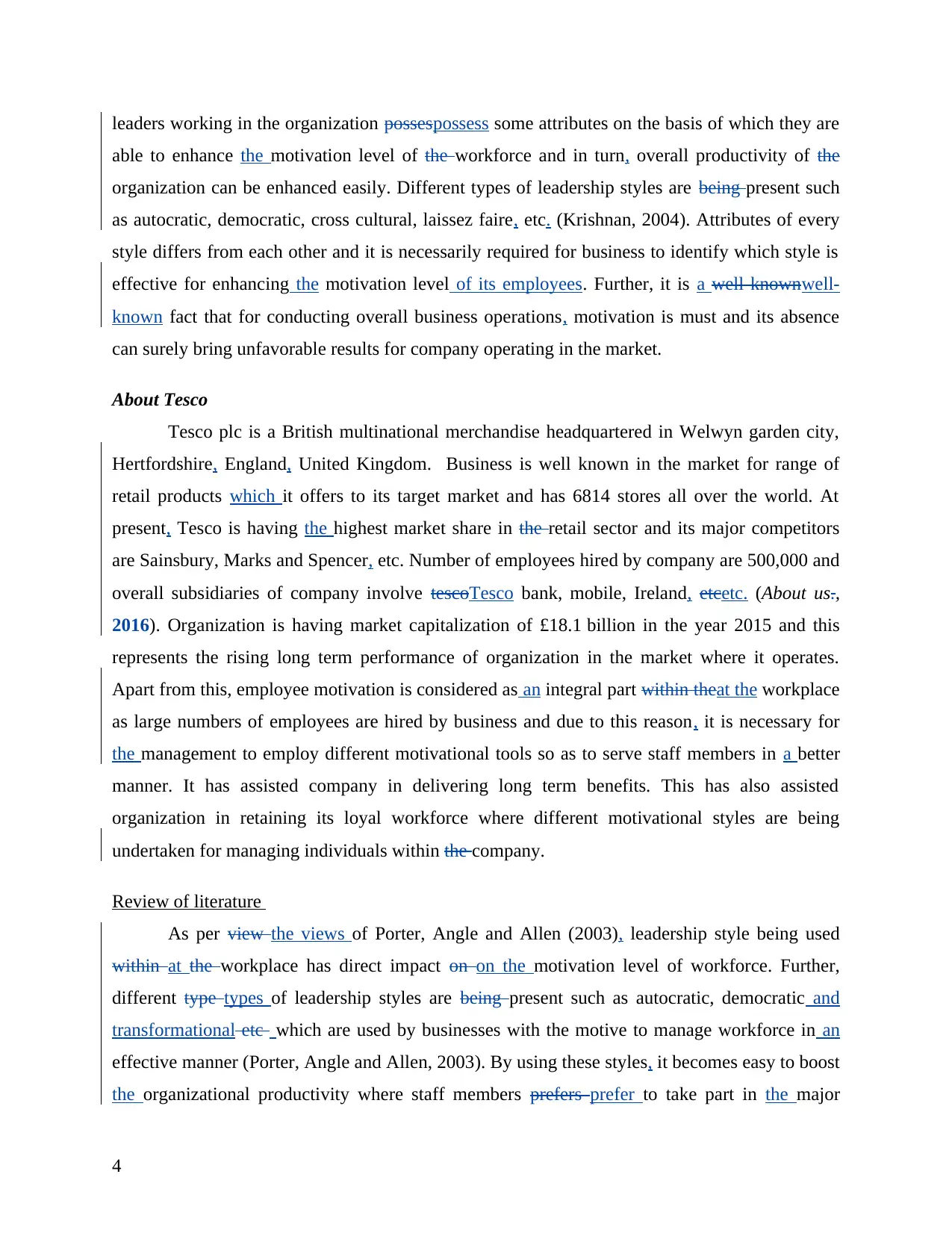
leaders working in the organization possespossess some attributes on the basis of which they are
able to enhance the motivation level of the workforce and in turn, overall productivity of the
organization can be enhanced easily. Different types of leadership styles are being present such
as autocratic, democratic, cross cultural, laissez faire, etc. (Krishnan, 2004). Attributes of every
style differs from each other and it is necessarily required for business to identify which style is
effective for enhancing the motivation level of its employees. Further, it is a well knownwell-
known fact that for conducting overall business operations, motivation is must and its absence
can surely bring unfavorable results for company operating in the market.
About Tesco
Tesco plc is a British multinational merchandise headquartered in Welwyn garden city,
Hertfordshire, England, United Kingdom. Business is well known in the market for range of
retail products which it offers to its target market and has 6814 stores all over the world. At
present, Tesco is having the highest market share in the retail sector and its major competitors
are Sainsbury, Marks and Spencer, etc. Number of employees hired by company are 500,000 and
overall subsidiaries of company involve tescoTesco bank, mobile, Ireland, etcetc. (About us.,
2016). Organization is having market capitalization of £18.1 billion in the year 2015 and this
represents the rising long term performance of organization in the market where it operates.
Apart from this, employee motivation is considered as an integral part within theat the workplace
as large numbers of employees are hired by business and due to this reason, it is necessary for
the management to employ different motivational tools so as to serve staff members in a better
manner. It has assisted company in delivering long term benefits. This has also assisted
organization in retaining its loyal workforce where different motivational styles are being
undertaken for managing individuals within the company.
Review of literature
As per view the views of Porter, Angle and Allen (2003), leadership style being used
within at the workplace has direct impact on on the motivation level of workforce. Further,
different type types of leadership styles are being present such as autocratic, democratic and
transformational etc which are used by businesses with the motive to manage workforce in an
effective manner (Porter, Angle and Allen, 2003). By using these styles, it becomes easy to boost
the organizational productivity where staff members prefers prefer to take part in the major
4
able to enhance the motivation level of the workforce and in turn, overall productivity of the
organization can be enhanced easily. Different types of leadership styles are being present such
as autocratic, democratic, cross cultural, laissez faire, etc. (Krishnan, 2004). Attributes of every
style differs from each other and it is necessarily required for business to identify which style is
effective for enhancing the motivation level of its employees. Further, it is a well knownwell-
known fact that for conducting overall business operations, motivation is must and its absence
can surely bring unfavorable results for company operating in the market.
About Tesco
Tesco plc is a British multinational merchandise headquartered in Welwyn garden city,
Hertfordshire, England, United Kingdom. Business is well known in the market for range of
retail products which it offers to its target market and has 6814 stores all over the world. At
present, Tesco is having the highest market share in the retail sector and its major competitors
are Sainsbury, Marks and Spencer, etc. Number of employees hired by company are 500,000 and
overall subsidiaries of company involve tescoTesco bank, mobile, Ireland, etcetc. (About us.,
2016). Organization is having market capitalization of £18.1 billion in the year 2015 and this
represents the rising long term performance of organization in the market where it operates.
Apart from this, employee motivation is considered as an integral part within theat the workplace
as large numbers of employees are hired by business and due to this reason, it is necessary for
the management to employ different motivational tools so as to serve staff members in a better
manner. It has assisted company in delivering long term benefits. This has also assisted
organization in retaining its loyal workforce where different motivational styles are being
undertaken for managing individuals within the company.
Review of literature
As per view the views of Porter, Angle and Allen (2003), leadership style being used
within at the workplace has direct impact on on the motivation level of workforce. Further,
different type types of leadership styles are being present such as autocratic, democratic and
transformational etc which are used by businesses with the motive to manage workforce in an
effective manner (Porter, Angle and Allen, 2003). By using these styles, it becomes easy to boost
the organizational productivity where staff members prefers prefer to take part in the major
4
Paraphrase This Document
Need a fresh take? Get an instant paraphrase of this document with our AI Paraphraser
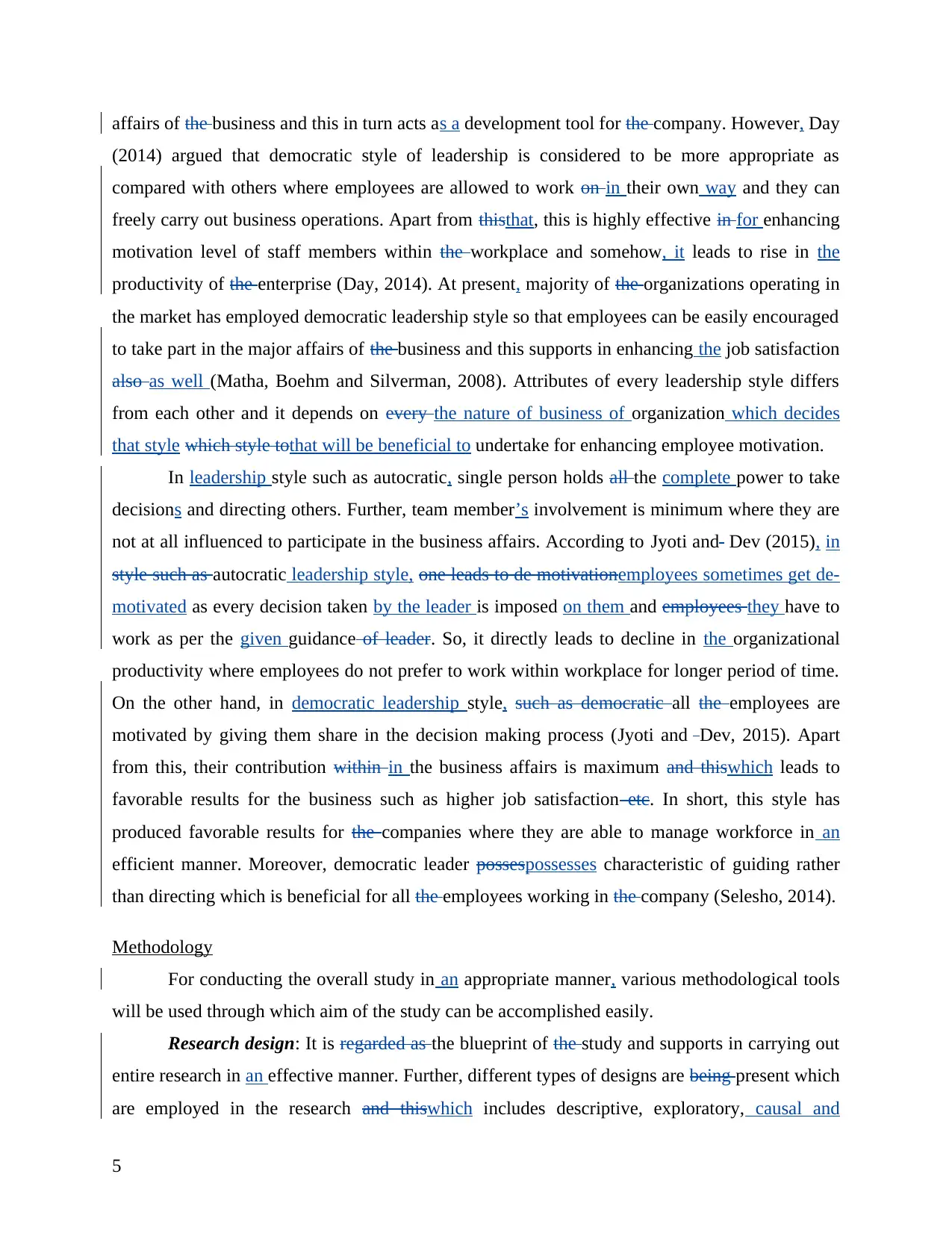
affairs of the business and this in turn acts as a development tool for the company. However, Day
(2014) argued that democratic style of leadership is considered to be more appropriate as
compared with others where employees are allowed to work on in their own way and they can
freely carry out business operations. Apart from thisthat, this is highly effective in for enhancing
motivation level of staff members within the workplace and somehow, it leads to rise in the
productivity of the enterprise (Day, 2014). At present, majority of the organizations operating in
the market has employed democratic leadership style so that employees can be easily encouraged
to take part in the major affairs of the business and this supports in enhancing the job satisfaction
also as well (Matha, Boehm and Silverman, 2008). Attributes of every leadership style differs
from each other and it depends on every the nature of business of organization which decides
that style which style tothat will be beneficial to undertake for enhancing employee motivation.
In leadership style such as autocratic, single person holds all the complete power to take
decisions and directing others. Further, team member’s involvement is minimum where they are
not at all influenced to participate in the business affairs. According to Jyoti and Dev (2015), in
style such as autocratic leadership style, one leads to de motivationemployees sometimes get de-
motivated as every decision taken by the leader is imposed on them and employees they have to
work as per the given guidance of leader. So, it directly leads to decline in the organizational
productivity where employees do not prefer to work within workplace for longer period of time.
On the other hand, in democratic leadership style, such as democratic all the employees are
motivated by giving them share in the decision making process (Jyoti and Dev, 2015). Apart
from this, their contribution within in the business affairs is maximum and thiswhich leads to
favorable results for the business such as higher job satisfaction etc. In short, this style has
produced favorable results for the companies where they are able to manage workforce in an
efficient manner. Moreover, democratic leader possespossesses characteristic of guiding rather
than directing which is beneficial for all the employees working in the company (Selesho, 2014).
Methodology
For conducting the overall study in an appropriate manner, various methodological tools
will be used through which aim of the study can be accomplished easily.
Research design: It is regarded as the blueprint of the study and supports in carrying out
entire research in an effective manner. Further, different types of designs are being present which
are employed in the research and thiswhich includes descriptive, exploratory, causal and
5
(2014) argued that democratic style of leadership is considered to be more appropriate as
compared with others where employees are allowed to work on in their own way and they can
freely carry out business operations. Apart from thisthat, this is highly effective in for enhancing
motivation level of staff members within the workplace and somehow, it leads to rise in the
productivity of the enterprise (Day, 2014). At present, majority of the organizations operating in
the market has employed democratic leadership style so that employees can be easily encouraged
to take part in the major affairs of the business and this supports in enhancing the job satisfaction
also as well (Matha, Boehm and Silverman, 2008). Attributes of every leadership style differs
from each other and it depends on every the nature of business of organization which decides
that style which style tothat will be beneficial to undertake for enhancing employee motivation.
In leadership style such as autocratic, single person holds all the complete power to take
decisions and directing others. Further, team member’s involvement is minimum where they are
not at all influenced to participate in the business affairs. According to Jyoti and Dev (2015), in
style such as autocratic leadership style, one leads to de motivationemployees sometimes get de-
motivated as every decision taken by the leader is imposed on them and employees they have to
work as per the given guidance of leader. So, it directly leads to decline in the organizational
productivity where employees do not prefer to work within workplace for longer period of time.
On the other hand, in democratic leadership style, such as democratic all the employees are
motivated by giving them share in the decision making process (Jyoti and Dev, 2015). Apart
from this, their contribution within in the business affairs is maximum and thiswhich leads to
favorable results for the business such as higher job satisfaction etc. In short, this style has
produced favorable results for the companies where they are able to manage workforce in an
efficient manner. Moreover, democratic leader possespossesses characteristic of guiding rather
than directing which is beneficial for all the employees working in the company (Selesho, 2014).
Methodology
For conducting the overall study in an appropriate manner, various methodological tools
will be used through which aim of the study can be accomplished easily.
Research design: It is regarded as the blueprint of the study and supports in carrying out
entire research in an effective manner. Further, different types of designs are being present which
are employed in the research and thiswhich includes descriptive, exploratory, causal and
5
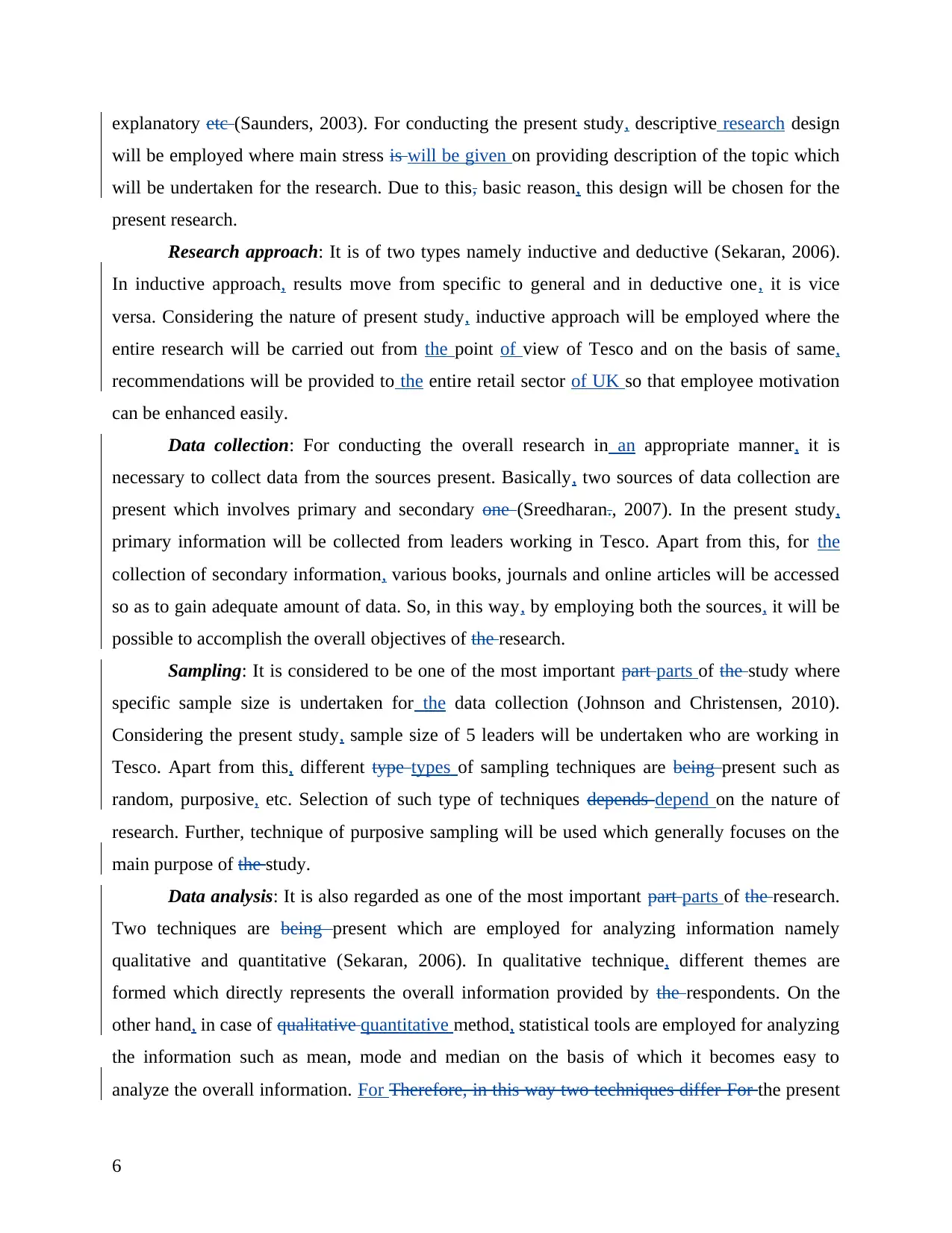
explanatory etc (Saunders, 2003). For conducting the present study, descriptive research design
will be employed where main stress is will be given on providing description of the topic which
will be undertaken for the research. Due to this, basic reason, this design will be chosen for the
present research.
Research approach: It is of two types namely inductive and deductive (Sekaran, 2006).
In inductive approach, results move from specific to general and in deductive one, it is vice
versa. Considering the nature of present study, inductive approach will be employed where the
entire research will be carried out from the point of view of Tesco and on the basis of same,
recommendations will be provided to the entire retail sector of UK so that employee motivation
can be enhanced easily.
Data collection: For conducting the overall research in an appropriate manner, it is
necessary to collect data from the sources present. Basically, two sources of data collection are
present which involves primary and secondary one (Sreedharan., 2007). In the present study,
primary information will be collected from leaders working in Tesco. Apart from this, for the
collection of secondary information, various books, journals and online articles will be accessed
so as to gain adequate amount of data. So, in this way, by employing both the sources, it will be
possible to accomplish the overall objectives of the research.
Sampling: It is considered to be one of the most important part parts of the study where
specific sample size is undertaken for the data collection (Johnson and Christensen, 2010).
Considering the present study, sample size of 5 leaders will be undertaken who are working in
Tesco. Apart from this, different type types of sampling techniques are being present such as
random, purposive, etc. Selection of such type of techniques depends depend on the nature of
research. Further, technique of purposive sampling will be used which generally focuses on the
main purpose of the study.
Data analysis: It is also regarded as one of the most important part parts of the research.
Two techniques are being present which are employed for analyzing information namely
qualitative and quantitative (Sekaran, 2006). In qualitative technique, different themes are
formed which directly represents the overall information provided by the respondents. On the
other hand, in case of qualitative quantitative method, statistical tools are employed for analyzing
the information such as mean, mode and median on the basis of which it becomes easy to
analyze the overall information. For Therefore, in this way two techniques differ For the present
6
will be employed where main stress is will be given on providing description of the topic which
will be undertaken for the research. Due to this, basic reason, this design will be chosen for the
present research.
Research approach: It is of two types namely inductive and deductive (Sekaran, 2006).
In inductive approach, results move from specific to general and in deductive one, it is vice
versa. Considering the nature of present study, inductive approach will be employed where the
entire research will be carried out from the point of view of Tesco and on the basis of same,
recommendations will be provided to the entire retail sector of UK so that employee motivation
can be enhanced easily.
Data collection: For conducting the overall research in an appropriate manner, it is
necessary to collect data from the sources present. Basically, two sources of data collection are
present which involves primary and secondary one (Sreedharan., 2007). In the present study,
primary information will be collected from leaders working in Tesco. Apart from this, for the
collection of secondary information, various books, journals and online articles will be accessed
so as to gain adequate amount of data. So, in this way, by employing both the sources, it will be
possible to accomplish the overall objectives of the research.
Sampling: It is considered to be one of the most important part parts of the study where
specific sample size is undertaken for the data collection (Johnson and Christensen, 2010).
Considering the present study, sample size of 5 leaders will be undertaken who are working in
Tesco. Apart from this, different type types of sampling techniques are being present such as
random, purposive, etc. Selection of such type of techniques depends depend on the nature of
research. Further, technique of purposive sampling will be used which generally focuses on the
main purpose of the study.
Data analysis: It is also regarded as one of the most important part parts of the research.
Two techniques are being present which are employed for analyzing information namely
qualitative and quantitative (Sekaran, 2006). In qualitative technique, different themes are
formed which directly represents the overall information provided by the respondents. On the
other hand, in case of qualitative quantitative method, statistical tools are employed for analyzing
the information such as mean, mode and median on the basis of which it becomes easy to
analyze the overall information. For Therefore, in this way two techniques differ For the present
6
⊘ This is a preview!⊘
Do you want full access?
Subscribe today to unlock all pages.

Trusted by 1+ million students worldwide
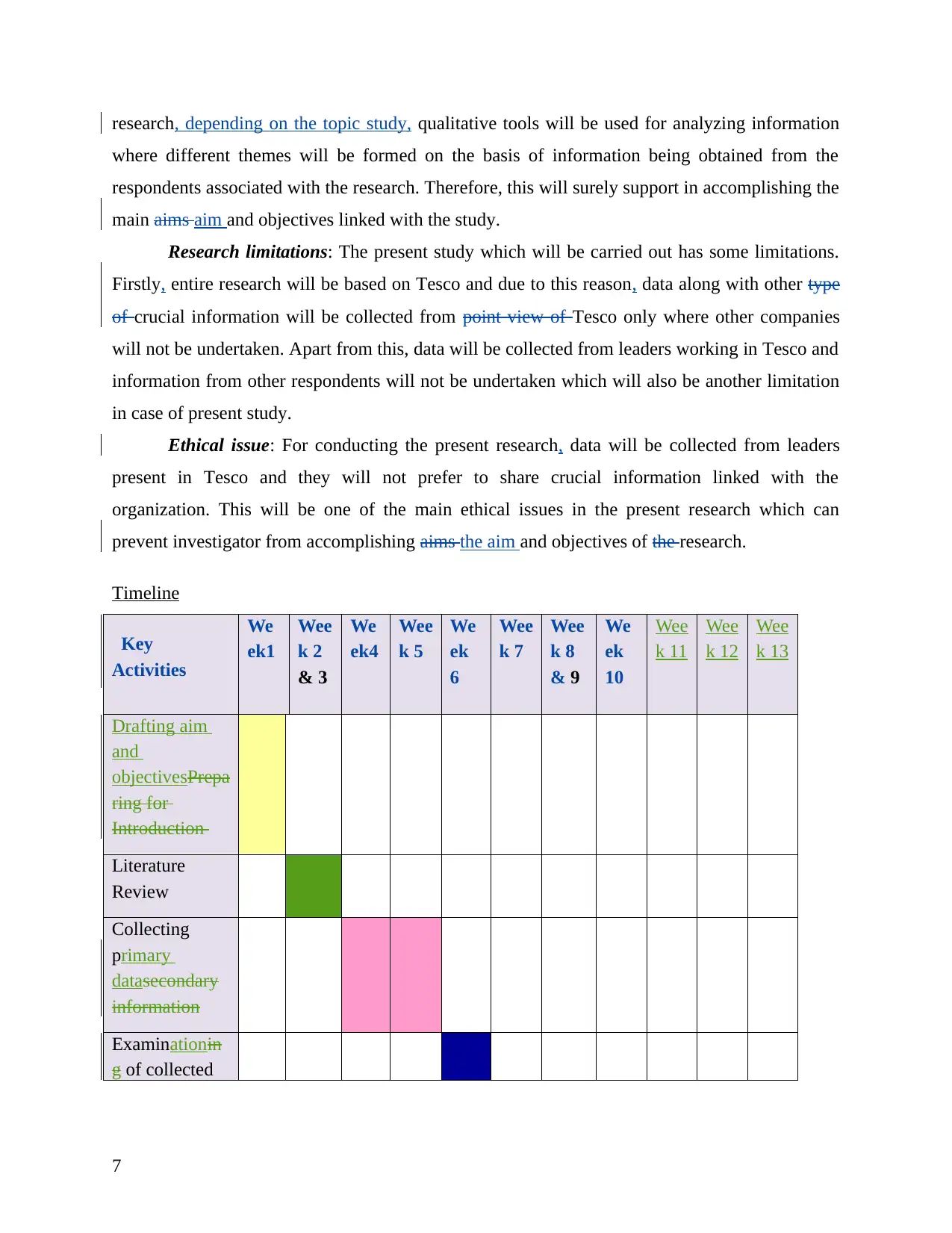
research, depending on the topic study, qualitative tools will be used for analyzing information
where different themes will be formed on the basis of information being obtained from the
respondents associated with the research. Therefore, this will surely support in accomplishing the
main aims aim and objectives linked with the study.
Research limitations: The present study which will be carried out has some limitations.
Firstly, entire research will be based on Tesco and due to this reason, data along with other type
of crucial information will be collected from point view of Tesco only where other companies
will not be undertaken. Apart from this, data will be collected from leaders working in Tesco and
information from other respondents will not be undertaken which will also be another limitation
in case of present study.
Ethical issue: For conducting the present research, data will be collected from leaders
present in Tesco and they will not prefer to share crucial information linked with the
organization. This will be one of the main ethical issues in the present research which can
prevent investigator from accomplishing aims the aim and objectives of the research.
Timeline
Key
Activities
We
ek1
Wee
k 2
& 3
We
ek4
Wee
k 5
We
ek
6
Wee
k 7
Wee
k 8
& 9
We
ek
10
Wee
k 11
Wee
k 12
Wee
k 13
Drafting aim
and
objectivesPrepa
ring for
Introduction
Literature
Review
Collecting
primary
datasecondary
information
Examinationin
g of collected
7
where different themes will be formed on the basis of information being obtained from the
respondents associated with the research. Therefore, this will surely support in accomplishing the
main aims aim and objectives linked with the study.
Research limitations: The present study which will be carried out has some limitations.
Firstly, entire research will be based on Tesco and due to this reason, data along with other type
of crucial information will be collected from point view of Tesco only where other companies
will not be undertaken. Apart from this, data will be collected from leaders working in Tesco and
information from other respondents will not be undertaken which will also be another limitation
in case of present study.
Ethical issue: For conducting the present research, data will be collected from leaders
present in Tesco and they will not prefer to share crucial information linked with the
organization. This will be one of the main ethical issues in the present research which can
prevent investigator from accomplishing aims the aim and objectives of the research.
Timeline
Key
Activities
We
ek1
Wee
k 2
& 3
We
ek4
Wee
k 5
We
ek
6
Wee
k 7
Wee
k 8
& 9
We
ek
10
Wee
k 11
Wee
k 12
Wee
k 13
Drafting aim
and
objectivesPrepa
ring for
Introduction
Literature
Review
Collecting
primary
datasecondary
information
Examinationin
g of collected
7
Paraphrase This Document
Need a fresh take? Get an instant paraphrase of this document with our AI Paraphraser
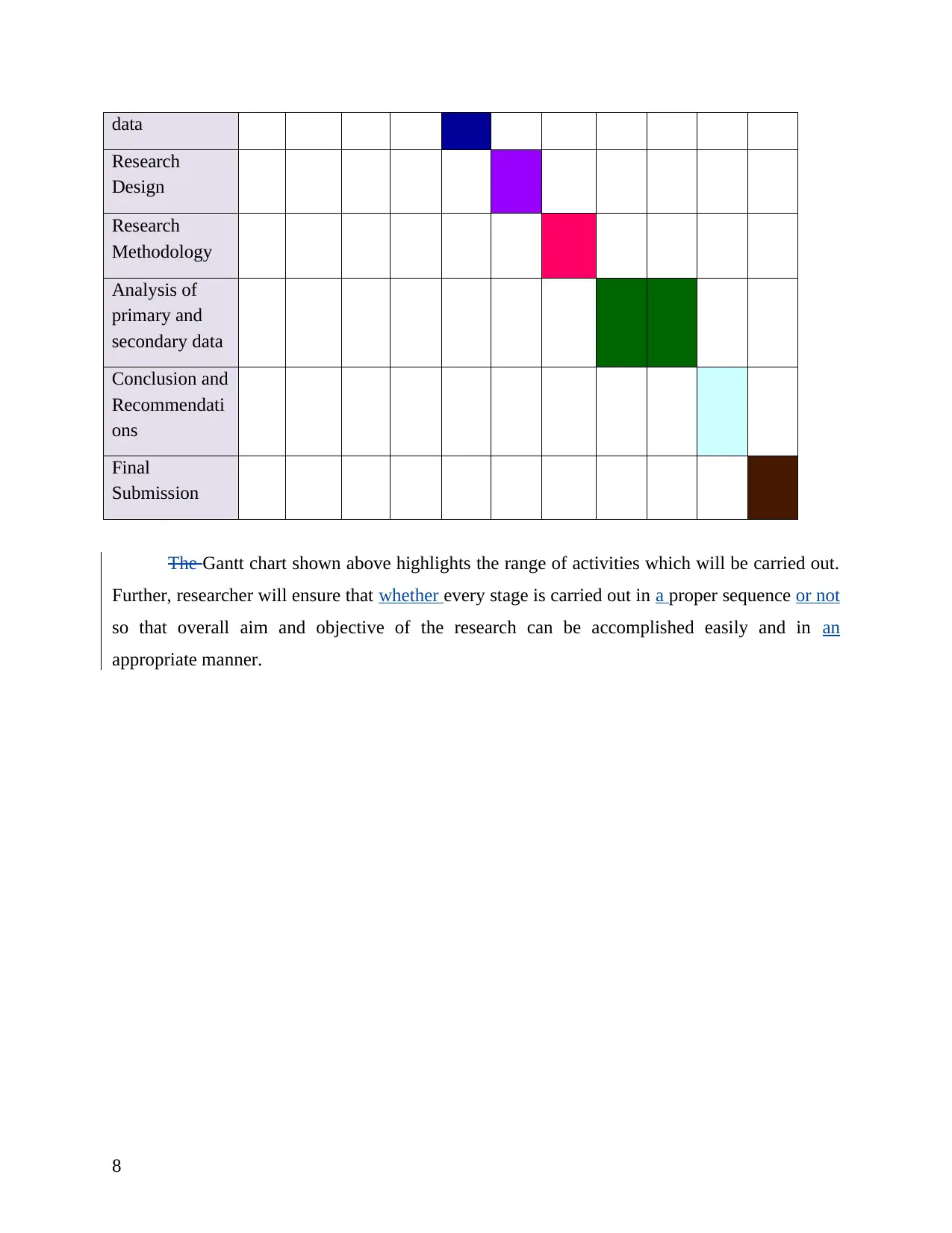
data
Research
Design
Research
Methodology
Analysis of
primary and
secondary data
Conclusion and
Recommendati
ons
Final
Submission
The Gantt chart shown above highlights the range of activities which will be carried out.
Further, researcher will ensure that whether every stage is carried out in a proper sequence or not
so that overall aim and objective of the research can be accomplished easily and in an
appropriate manner.
8
Research
Design
Research
Methodology
Analysis of
primary and
secondary data
Conclusion and
Recommendati
ons
Final
Submission
The Gantt chart shown above highlights the range of activities which will be carried out.
Further, researcher will ensure that whether every stage is carried out in a proper sequence or not
so that overall aim and objective of the research can be accomplished easily and in an
appropriate manner.
8
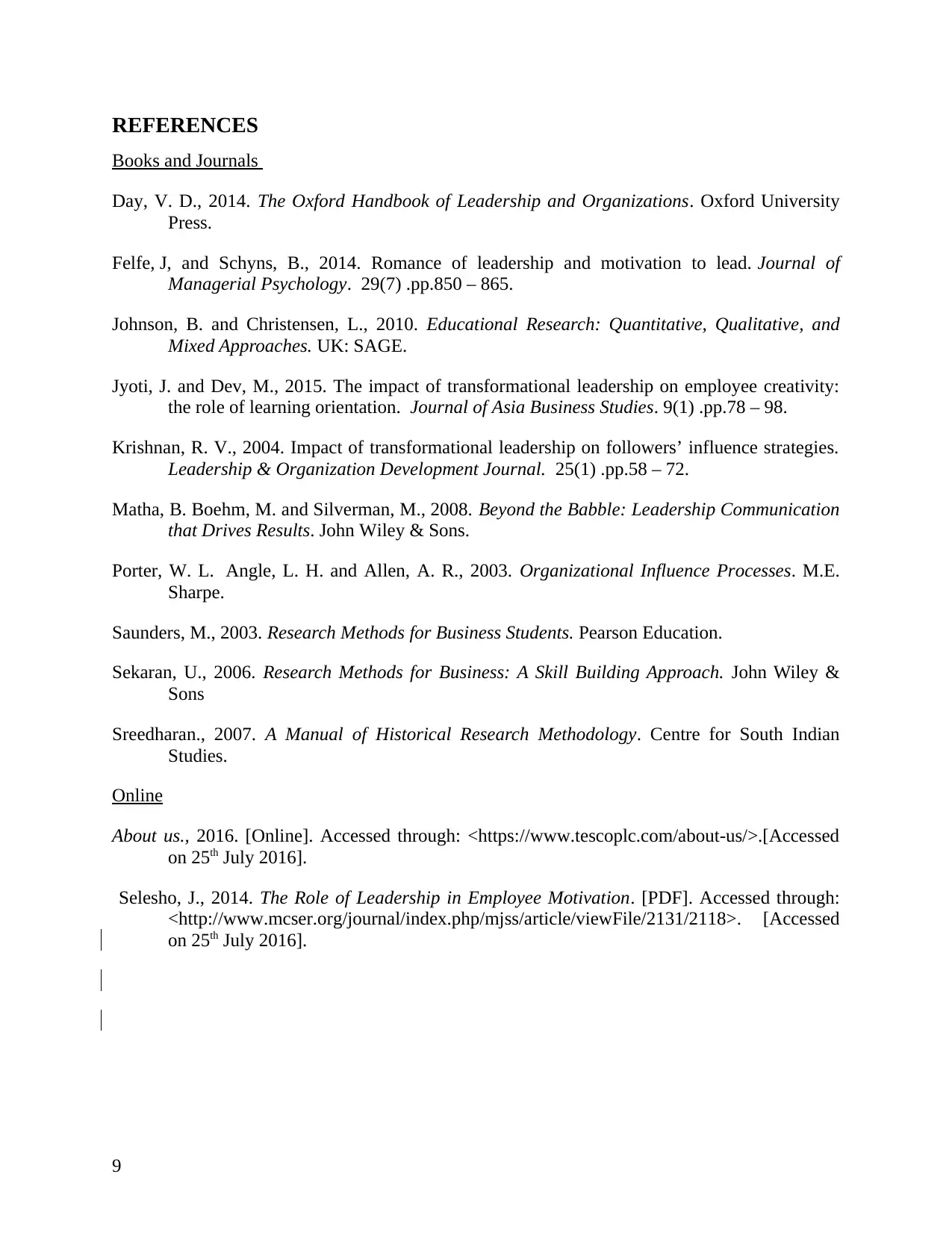
REFERENCES
Books and Journals
Day, V. D., 2014. The Oxford Handbook of Leadership and Organizations. Oxford University
Press.
Felfe, J, and Schyns, B., 2014. Romance of leadership and motivation to lead. Journal of
Managerial Psychology. 29(7) .pp.850 – 865.
Johnson, B. and Christensen, L., 2010. Educational Research: Quantitative, Qualitative, and
Mixed Approaches. UK: SAGE.
Jyoti, J. and Dev, M., 2015. The impact of transformational leadership on employee creativity:
the role of learning orientation. Journal of Asia Business Studies. 9(1) .pp.78 – 98.
Krishnan, R. V., 2004. Impact of transformational leadership on followers’ influence strategies.
Leadership & Organization Development Journal. 25(1) .pp.58 – 72.
Matha, B. Boehm, M. and Silverman, M., 2008. Beyond the Babble: Leadership Communication
that Drives Results. John Wiley & Sons.
Porter, W. L. Angle, L. H. and Allen, A. R., 2003. Organizational Influence Processes. M.E.
Sharpe.
Saunders, M., 2003. Research Methods for Business Students. Pearson Education.
Sekaran, U., 2006. Research Methods for Business: A Skill Building Approach. John Wiley &
Sons
Sreedharan., 2007. A Manual of Historical Research Methodology. Centre for South Indian
Studies.
Online
About us., 2016. [Online]. Accessed through: <https://www.tescoplc.com/about-us/>.[Accessed
on 25th July 2016].
Selesho, J., 2014. The Role of Leadership in Employee Motivation. [PDF]. Accessed through:
<http://www.mcser.org/journal/index.php/mjss/article/viewFile/2131/2118>. [Accessed
on 25th July 2016].
9
Books and Journals
Day, V. D., 2014. The Oxford Handbook of Leadership and Organizations. Oxford University
Press.
Felfe, J, and Schyns, B., 2014. Romance of leadership and motivation to lead. Journal of
Managerial Psychology. 29(7) .pp.850 – 865.
Johnson, B. and Christensen, L., 2010. Educational Research: Quantitative, Qualitative, and
Mixed Approaches. UK: SAGE.
Jyoti, J. and Dev, M., 2015. The impact of transformational leadership on employee creativity:
the role of learning orientation. Journal of Asia Business Studies. 9(1) .pp.78 – 98.
Krishnan, R. V., 2004. Impact of transformational leadership on followers’ influence strategies.
Leadership & Organization Development Journal. 25(1) .pp.58 – 72.
Matha, B. Boehm, M. and Silverman, M., 2008. Beyond the Babble: Leadership Communication
that Drives Results. John Wiley & Sons.
Porter, W. L. Angle, L. H. and Allen, A. R., 2003. Organizational Influence Processes. M.E.
Sharpe.
Saunders, M., 2003. Research Methods for Business Students. Pearson Education.
Sekaran, U., 2006. Research Methods for Business: A Skill Building Approach. John Wiley &
Sons
Sreedharan., 2007. A Manual of Historical Research Methodology. Centre for South Indian
Studies.
Online
About us., 2016. [Online]. Accessed through: <https://www.tescoplc.com/about-us/>.[Accessed
on 25th July 2016].
Selesho, J., 2014. The Role of Leadership in Employee Motivation. [PDF]. Accessed through:
<http://www.mcser.org/journal/index.php/mjss/article/viewFile/2131/2118>. [Accessed
on 25th July 2016].
9
⊘ This is a preview!⊘
Do you want full access?
Subscribe today to unlock all pages.

Trusted by 1+ million students worldwide
1 out of 9
Related Documents
Your All-in-One AI-Powered Toolkit for Academic Success.
+13062052269
info@desklib.com
Available 24*7 on WhatsApp / Email
![[object Object]](/_next/static/media/star-bottom.7253800d.svg)
Unlock your academic potential
Copyright © 2020–2025 A2Z Services. All Rights Reserved. Developed and managed by ZUCOL.





